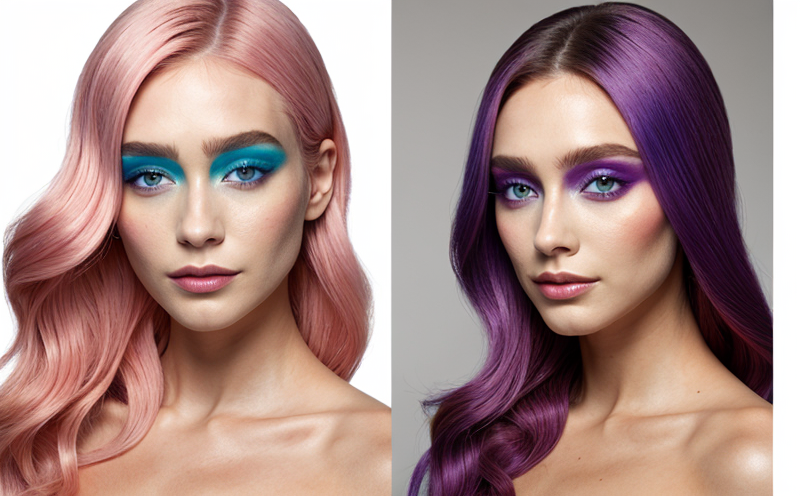Opacity Testing in Lip and Eye Products
In the realm of cosmetic product development, ensuring that lip and eye products meet high standards of opacity is crucial. Opacity testing plays a pivotal role in validating the consistency, performance, and aesthetic appeal of these products. This service ensures that the color pigments within lipstick or eyeshadow are evenly distributed and provide the desired level of coverage.
Opacity refers to the extent to which light is prevented from passing through a substance. In cosmetics, it directly impacts how effectively a product applies to the skin or lips without leaving visible streaks or patches. For instance, when testing lipstick opacity, we aim to ensure that the color adheres uniformly and provides a smooth finish on the lips.
The first step in performing opacity testing involves preparing the sample by applying the cosmetic product evenly across the designated area, typically a standardized test patch. The sample is then evaluated visually under controlled lighting conditions that mimic natural daylight or artificial light sources used during application. This ensures consistency and replicability of results.
Once applied, various techniques are employed to assess opacity, including:
- Visual Inspection: Observing the product's appearance for even color distribution.
- Spectrophotometric Measurement: Using a spectrophotometer to measure light transmission through the sample. This provides quantitative data on how much light is blocked by the pigment, which directly correlates with opacity levels.
- Instrumental Analysis: Employing advanced optical instruments such as haze meters or densitometers to analyze the opacity of the product.
The ultimate goal of this testing process is to achieve a balance between aesthetic appeal and functional performance. For example, achieving the right level of opacity in eyeshadow ensures that it adheres well without creasing while providing an even color application. Excessive or insufficient opacity can lead to user dissatisfaction, which ultimately affects brand reputation.
Standards such as ISO 2847:2018 and ASTM D1003-17 provide guidelines for determining the opacity of cosmetic products. These standards ensure that testing methods are consistent across different laboratories, enhancing reliability and trustworthiness.
In addition to meeting aesthetic expectations, opacity testing is also important from a regulatory perspective. Regulatory bodies like the FDA and the EC require manufacturers to demonstrate compliance with specific standards that ensure product safety and efficacy.
The importance of this service extends beyond mere appearance; it also contributes significantly to consumer satisfaction and brand loyalty. By ensuring that products meet high opacity standards, we help brands maintain a consistent quality across their product lines, which is essential for repeat purchases and positive customer reviews.
Applied Standards
The primary standard governing opacity testing in cosmetics is ISO 2847:2018. This international standard provides detailed procedures for the determination of lightness, color coordinates, and chroma on colored materials. It includes specific guidelines for preparing samples, setting up measurement instruments, and interpreting results.
Additionally, ASTM D1003-17 offers supplementary methods that enhance the accuracy of opacity measurements. These standards are essential for ensuring consistency in testing across different laboratories and jurisdictions.
The EC's regulations on cosmetic products also emphasize the importance of meeting international standards to ensure consumer safety and effectiveness.
International Acceptance and Recognition
- Australia: Opacity testing is recognized by the ACCC, ensuring that products meet local consumer standards.
- United States: The FDA accepts international standards for cosmetic safety, including opacity tests.
- European Union: Opacity testing is part of the harmonized standardization process within the EU, ensuring that products comply with the EC's directives.
- Japan: The Japanese Ministry of Health, Labor, and Welfare recognizes international standards for cosmetic opacity.
- India: The Drug Controller General of India (DCGI) mandates compliance with ISO and ASTM standards for cosmetics.
- Singapore: The Singapore Health Sciences Authority (HSA) accepts international standards in its regulatory framework.
- China: China's National Medical Products Administration (NMPA) aligns with global standards, including opacity testing methods prescribed by ISO and ASTM.
- Brazil: Brazil's ANVISA recognizes international standards for cosmetic safety assessments, which include opacity tests.
Environmental and Sustainability Contributions
Incorporating transparency in the manufacturing process is a significant step towards sustainability. By ensuring that the opacity of color cosmetics adheres to strict standards, we reduce waste from product returns due to dissatisfaction with appearance or application. This not only enhances customer satisfaction but also contributes positively to environmental conservation.
Furthermore, by providing accurate and reliable opacity testing results, manufacturers can optimize their product formulations, potentially reducing the use of raw materials without compromising quality. This efficiency in resource utilization aligns well with broader sustainability goals within the cosmetics industry.





